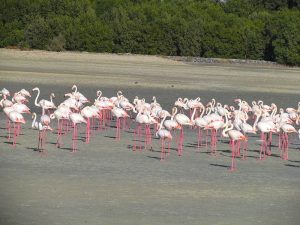 “Nature has provided ecosystems and their benefits to us for free… perhaps because this capital has been provided freely to us, we humans have tended to view it as limitless, abundant, and thus perhaps always available for our use, exploitation, and conversion.” (p.3)
“Nature has provided ecosystems and their benefits to us for free… perhaps because this capital has been provided freely to us, we humans have tended to view it as limitless, abundant, and thus perhaps always available for our use, exploitation, and conversion.” (p.3)
The modern economy’s obsession with competitive consumption and endless exploitation of natural resources is at the root of the environmental mess we find ourselves in. It has forced us to digger deeper for oil, experiment with all sorts of ecologically dubious methods to secure cheap energy, cut down trees to make way for industrial-scale food production, ruin mangroves for shrimp farms and spew out pollution which has now been shown to cause extreme weather.
However, in his latest book, ‘Capitalizing on Nature- Ecosystems as Natural Assets’, Edward Barbier argues that the economy can also be part of the solution. If we are able to conceive of natural ecosystems and the various services and benefits they provide us with as a form of wealth, they could be protected. The benefit of exploiting natural assets would then be weighed up against the benefits of converting them into other forms of wealth, and hopefully, this would lead to better ecological decisions.
In the first chapter of the book, Barbier outlines the scale of the ecological problem and he then goes onto explore the benefits of protecting our environment in chapter two. He argues that “the pervasive problem of ecological scarcity results directly from our failure to treat ecosystems as economic assets,” (p.22) and our disregard for the services [purifying water, controlling floods, reducing pollution, environment for recreation, pollination, climate regulation] that the natural ecosystems provide. As they are not marketed goods, it seems there has been little effort to stop their depletion.
Using a model which focuses on land use, the two following chapters discuss the process of getting the price right to ensure balanced conservation and also taking into consideration the unknown benefits the natural ecosystem, irreversible loss and resilience. These two chapters get quite technical and I found it hard to follow in places- maths and economics were never strong points and I am quite easily put off by long equations. Even so, the use of case studies was useful here and helped highlight how these models could be applied. Chapter five also looks at the difficult situation that we found ourselves with regards to preserving natural assets- namely, that most of the important ecosystems are in developing regions where there is intense pressure to use resources for development rather than conserve them due to issues such as growing population and poverty.
The solution? It’s simple, Barbier, insists. You pay poorer nations to keep these natural assets by compensating them for foregoing the export earnings. Yet this is where the argument falters for me as Barbier talks again and again of the logic of protecting nature because it contributes to our development, health and also because it is irreplaceable but the fact remains that translating this logic into the market forces of the economy is the difficult bit. And here, he fails to deliver any winning ideas. He accepts that not only would it be expensive to put in place a system to protect natural assets but it would be a huge challenge to get economies to recognise the monetary value of ecosystem. In fact, Barbier sums up the predicament quite succinctly: “the high relative transaction costs involved in making the necessary market, policy and institutional changes seem prohibitive compared to perpetuating the same pattern of production and natural resource use.”
So, an interesting read but it doesn’t offer any insight into how we can overcome the barriers to change that the environmental movement is grappling with. I don’t want to be too harsh on Barbier for not coming up with ‘the solution’, which various summits and conferences have also failed to come up with, I just feel too much time was spent going over and over the arguments that nature should be economically valued without looking at the real issue of how this would play out in the real world. More research is suggested (as is always by academics) and although I can’t argue against that, more action on the things we do know feels like the important thing to be focusing on now. Barbier also sidelines the critique that the economy’s shortcomings, with regards to valuing non-market things (i.e. nature) is an inherent flaw of competitive capitalism which cannot be overcome by simply putting a price on nature.
Edward B. Barbier is the John S Bugas Professor of Economics at the University of Wyoming. He has over 25 years experience as an environmental and resource economist, working on natural resource and development issues as well as the interface between economics and ecology.
Title: Capitalizing on Nature- Ecosystems as Natural Assets
Author: Edward B. Barbier
ISBN: 9780521189279
Price: £19.99
For more book reviews see:
Edgelands: Journeys into England’s True Wilderness
Book Review: I’m With The Bears
Book Review: ‘ The Ethical Tragedy of Climate Change’ by Stephen Gardiner



